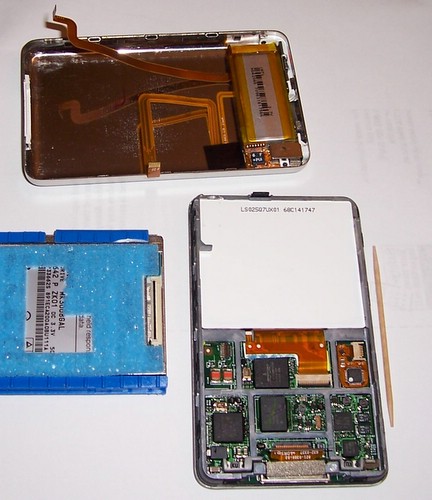The other day my Mom came by for a visit and she had brought along a 1st generation iPod shuffle that she “had never got it to work properly”. Being one of the geeks in the family, I tend to get random computers and what not brought by for me to fix up – so this was no surprise. I zipped upstairs and plugged it into my PC and it was recognized and looked to be fine.
It was a bank account give away my Mom had picked up a year or two ago, and apparently she has no use for it and I was free to hang on to it – or find it a happy owner. Initially my reaction was, hmm.. who’s going to want this? Then Jenn had the insight to suggest that I use it. It took a while for me to warm up to the idea.
It appears my 30G Video is dead – or at least, the logic board is bad. I could likely buy a used one locally for around $120 either for parts, or just as a replacement. There is a good chance I could recover some of the cost of a new device by parting out my busted one as the drive and screen appear to be in “ok” shape (and have some value). Of course, the (refurbished) 8G touch is tempting – but going that route means living with a subset of my music. So.. if I can fill the portable music gap with this old (free!) shuffle, it will also let me experiment with life with a subset music collection.
The shuffle is actually a good match for my music listening, for the most part – I listen to a single smart playlist on shuffle. I did use the video on plane trips to watch ripped DVD movies, and I’ll miss that. As well, ever once in a while I’d get a song served up to me that I didn’t know who (or what) it was – having a display is nice there.
The first challenge was deciding what should go on the shuffle. Based on my past toying around with playlists, I simply fired up MusicIP and used it to build a new playlist starting with the Liar’s Rosebush track Artcrime. The free version of MusicIP stops you at 75 tracks, but the 512MB shuffle can only store around 70 tracks at my MP3 encoding rate, it’s fate I tell you.
Secondly I had to fight with iTunes to get it to copy the playlist onto the shuffle in the order of the songs on the playlist. I managed to make this work, but I’m not sure I can explain it – the key is to get iTunes to copy files in the correct order. I’ll just say again how much I dislike iTunes on Windows, its performance really eats away at the Apple “cool factor” for me.
So I’ve joined the iPod cult again (did I ever really leave?) rocking some retro gear. Thanks Mom!





